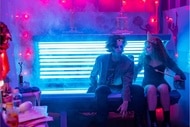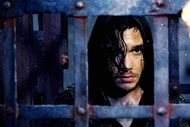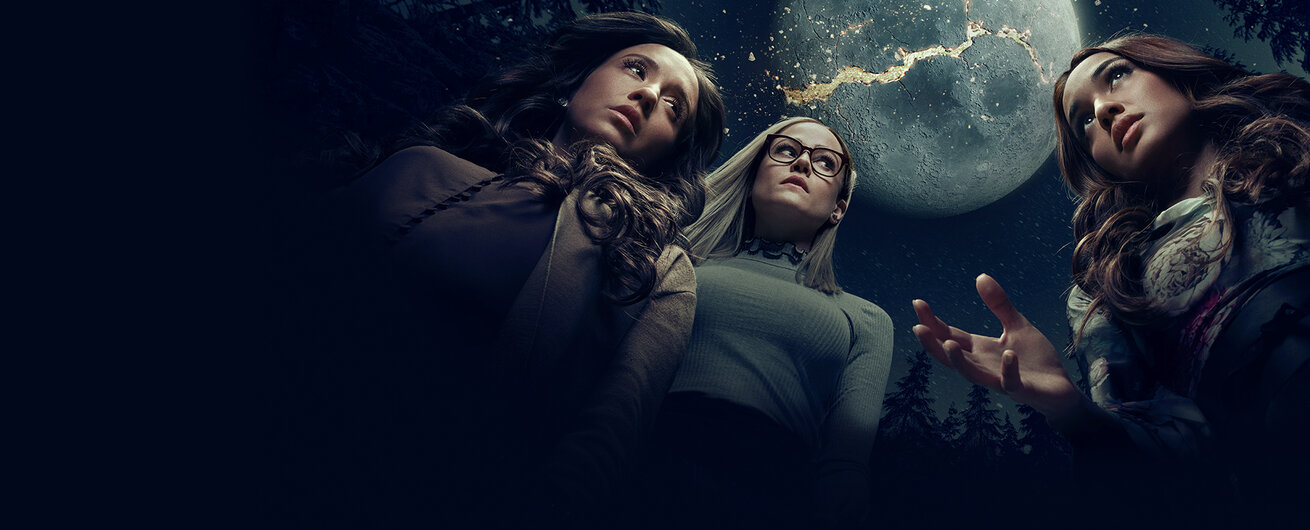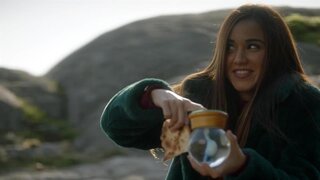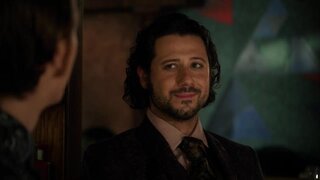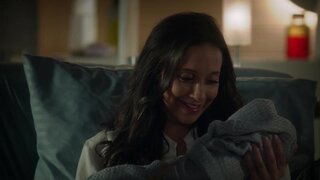Witches are back, casting a spell over pop culture when we need them most

It's the season of the witch, some might say. Look on television and streaming – shows like Chilling Adventures of Sabrina (back for a new season on Netflix), A Discovery of Witches (on AMC and BBC America), The Magicians (currently wrapping up season four on SYFY), and Charmed are bewitching audiences. And look on the news – the language of witchery seems to have infiltrated our politics.
Real-life witches are getting in on the action as well. As a political protest, around 60 of them gathered before a Brooklyn altar to hex Supreme Court Justice Brett Kavanaugh, Senate Majority Leader Mitch McConnell, and President Trump. The witches inside chanted in Latin ("Mortuus est rex, audi nos clamamos, eripe capaut, ossa eius uri, efundam sal terrae, canticum ira noster, ira est mater nostra") while a crowd of Christian sang hymns and shouted condemnations, protesting the protestors. And did you know there were out-and-out pagans running for political office?
What's this all about?
That's the kind of question a certain teenage witch and her horror-fan pals on Chilling Adventures of Sabrina like to bat around on their show. Are all monsters actually metaphors? Are the zombies in Night of the Living Dead really telling a tale about the Cold War, civil rights, and the collapse of the nuclear family? Is The Fly really about body dysmorphia? Do vampires stand in for sexual desire (or sexually-transmitted disease)? Do werewolves represent loss of control of one sort or another? And why do certain of these creatures dominate the public imagination at certain times, but not at others?
Deborah Harkness, a professor of history at USC and the author of A Discovery of Witches book series, has a professional interest in that last question. "I torture my students when I say, 'Okay, so what is it about this moment that makes it conducive to one supernatural creature, and not another?'" she says. "There's a whole buffet of options, so when the 19th century went through a fairy moment, why was it fairies and not werewolves? Why is it witches now?" Harkness and other experts helped us figure it out.
An Ugly History
Unlike vampires, werewolves, and fairies, witches have real-life counterparts, both self-identified and – in the past, at least – unjustly accused. Both the TV show and podcast Lore and the Salem deep-dive podcast Unobscured — both created by Aaron Mahnke — explore how witches were considered threats to the community and how certain women became scapegoats. One of the Lore stories this season concerns a woman named Mary Webster, who was tried as a witch more than once, was acquitted for lack of evidence, but was ultimately hanged by her neighbors anyway. (She survived, though, and author Margaret Atwood claims her as an ancestor.)
"This is just a woman who is by herself, with her cat, reading her books," says actress Paula Malcolmson, who plays Mary Webster in Lore. "But it was a very superstitious time. It could have been something in the rye that they were eating, an LSD-like hallucinogen and made people start tripping and imagining things. If there was a sickness, they would put the blame on strange women who lived on the edge of town."
The 16th and 17th Centuries were "a target-rich environment for bad things happening," Harkness says. "People wanted to find somebody to blame: 'I don't like what's happening. It can't be my fault. Whose fault is it?' We used to think that it was midwives, old women, impoverished women who were the focus." Now we know that there were more economic and political targets. In the European witch trials, around 100,000 people were accused, and some 40-50,000 were executed. 70 to 80 percent of these were women – women who were single, widowed, or divorced, or who stood to inherit or had inherited property. Same for the 344 cases in New England.
Independent women, in other words — women who were a threat to the Puritanical social order and the patriarchal inheritance system. Some were connected to organized peasant rebellions, and some were just considered nasty women — sarcastic, argumentative, unpopular. (The ultimate crime: being unlikable.)
The same kind of women are still targeted in modern-day witch hunts, where people are still accused of practicing witchcraft. And some would argue, those witch hunts have transformed into other ways to oppress women, and the symbol of woman-as-witch is a potent political tool. (Remember the Republican merchandise sporting the photo of Hillary Clinton riding a broom?)
"I was just reading about this because I'm obsessed with everything that has to do with women's history and the Salem witch trials," says actress Jade Tailor, who plays Kady on The Magicians. "Women were often chastised and thrown into the fire – literally – just for speaking up, and I think there is something to be said about reframing that, about shifting that story. Why women were put in that position."
From Wicked and Wanton to Cute and Kick-Ass
Although witches were celebrated in ancient mythology, medieval lore painted them as more sinister. Morgan le Fay, who was portrayed as a healer in early tales, became a villain in the mythic universe of King Arthur — a witch who seduced her own half-brother. Before long, pious clergymen were declaring that witches were in league with dark forces with Satan himself.
The infamous witch-hunter manual Malleus Maleficarum ("When a woman thinks alone, she thinks evil") was a key prosecutorial text in the witchcraft trials of the 16th and 17th Century. Popular literature also piled on, from Shakespeare's haggy Weird Sisters to the Grimm brothers' cackling child-eaters. Any woman who didn't want to bear or raise children? Suspect.
Later came L. Frank Baum's Oz books, which accepted that there could be good witches as well as wicked ones. Women's magazines in the early 20th Century started depicting witches as beautiful. Next came desirable, domesticated witches, such as Jennifer in the 1942 film I Married a Witch, Gillian in the 1950 Broadway play and 1958 film Bell, Book, and Candle, and Samantha in the 1960s TV series Bewitched. These were supernatural women — some with twitchy little noses! — redeemed by their love for mortal men.
The original Sabrina comic book character was also born in the 1960s, and Chilling Adventures of Sabrina comic book writer and TV showrunner Roberto Aguirre-Sacasa says the character's biggest moments seem to coincide with different waves of feminism: her birth "during the second wave of feminism and the women's civil rights movement," her 1990s TV show with the third wave, and her latest with the current wave.
"Once again, battle lines are being drawn about women's bodies," he says. "A lot of the same issues are still being discussed. Sabrina is a metaphor for any young woman who says, 'I don't necessarily believe that anyone should tell me what I can and can't do, especially with my body.' Sabrina is an allegory for female empowerment."
As depictions of witches continued into the 1990s, many of them were little kids and teenagers (the first Harry Potter books, the first run of Charmed, and The Craft), which helped make them even more adorable. Who doesn't like witches these days? (Well, we'll get back to that.)
Spirituality Crisis
Actual witches — pagans, Wiccans, practitioners of witchcraft have existed for thousands of years. But the interest in witchcraft and feminism, it seems, waxes and wanes in 20-year-cycles — seasons of the witch, if you like. In the '90s, The Craft had the unexpected result of sparking interest in joining covens. And we're in another one of those cycles now, which might explain why we're getting a reboot of The Craft with a female director.
Alex Mar, the author of Witches of America, estimates that as many as a million people around the country practice some form of paganism. "For obvious reasons," she says, "it's hard to get precise numbers on people who are dedicated witches, pagan priests and priestesses. A lot of them still in the closet about this. But it's a legitimate new religious movement that needs to be taken seriously."
Then there are the dabblers — people who may not identify as pagans or witches, but who like the aesthetic, but it's not always a seasonal thing just for Halloween. "This idea of spirituality that is up-and-coming right now is removed from the idea of religion," says actress Adeline Rudolph, who plays Agatha on Chilling Adventures of Sabrina. "The idea of crystals and omens and things like that."
These are dismaying words to people like Dakota Bracciale, who led the big Brooklyn hex on Kavanaugh and company. "We're inundated with people who are trying to carry out what I call the gentrification of witchcraft," Bracciale says. "It's yoga pants-wearing, crystal-rubbing, Chai latte-sipping white women who want to come in and colonize witchcraft and make it their own little pet project."
But witchcraft is also seeing a surge of growth from marginalized people who see it as a source of alternate power. "If I had been a TV or film executive during the 2016 presidential campaign," Mar says, "I would have been fast-tracking any story that came down the pipeline that had to do with witchcraft and young women exploring the occult, because it's such an obvious response."
Reclaiming Victimhood
In response to repression, empowered women began calling themselves witches as a disruptive cultural stance. The members of W.I.T.C.H. — a radical group formed in 1968 — saw themselves as guerilla feminists and resistance fighters. Outfitted with pointy black hats and brooms, they hexed Wall Street and protested Playboy Clubs, beauty pageants, and weddings. (One of their slogans was "Always a bride, never a person.")
The same kind of move is happening now – hence the hex on Kavanaugh — but with the ironic twist of the oppressors casting themselves as the persecuted victims at the same time. "What's happening in the real world now, if you had pitched that five years ago, nobody would believe you," says actress Olivia Taylor Dudley, who plays Alice on The Magicians. "It sounds ridiculous, but it's happening."
Like Trump calling investigations into Russian interference in the election "the single greatest witch hunt of a politician in American history!"Like accused sexual abuser Woody Allen using the phrase to defend another accused sexual abuser, Harvey Weinstein. (Lindy West shot back, "Sure, if you insist, it's a witch hunt. I'm a witch, and I'm hunting you.") Like Lindsay Graham, when defending accused sexual assaulter Brett Kavanaugh, responding, "Why don't we dunk him in water and see if he floats?"
"To call the #MeToo movement a witch hunt implies that the men are the witches, right?" Mar says. "The falsely accused, the victims, the misunderstood, the vulnerable, the outsiders? When in reality, they are the opposite. They're the very embodiment of the patriarchy and corporate culture, in many cases."
"I think a lot about that," says Magicians co-showrunner Sera Gamble. "The fact that it's really at the forefront of consciousness, even really privileged, really comfortable people are concerned. There's nothing revolutionary about #MeToo to people who have walked around women their whole lives. We didn't just start to experience things like rape culture. I wouldn't blame any of them for rolling their eyes and being like, 'This has been my day-to-day experience of life in this country forever.' #MeToo started trending because we reached a critical mass of women needing to talk about it. And we can apply that to a lot of what's going on in a lot of different sectors in this country right now, and the idea of witches and alternative means of getting power because the system's so f***ed up, is interesting to me."
All of which just makes the metaphor even more resonant for this particular moment, for anyone who feels like they could use a little witch-ful thinking to get through the day. "It's escapism," says actor Rick Worthy, who plays Dean Fogg on The Magicians, "but if you could wave a wand, or do ritual hand movements like we do on the show, and you could change someone's thought patterns, like Trump or Kavanaugh, then the world might move a bit in the right direction."




